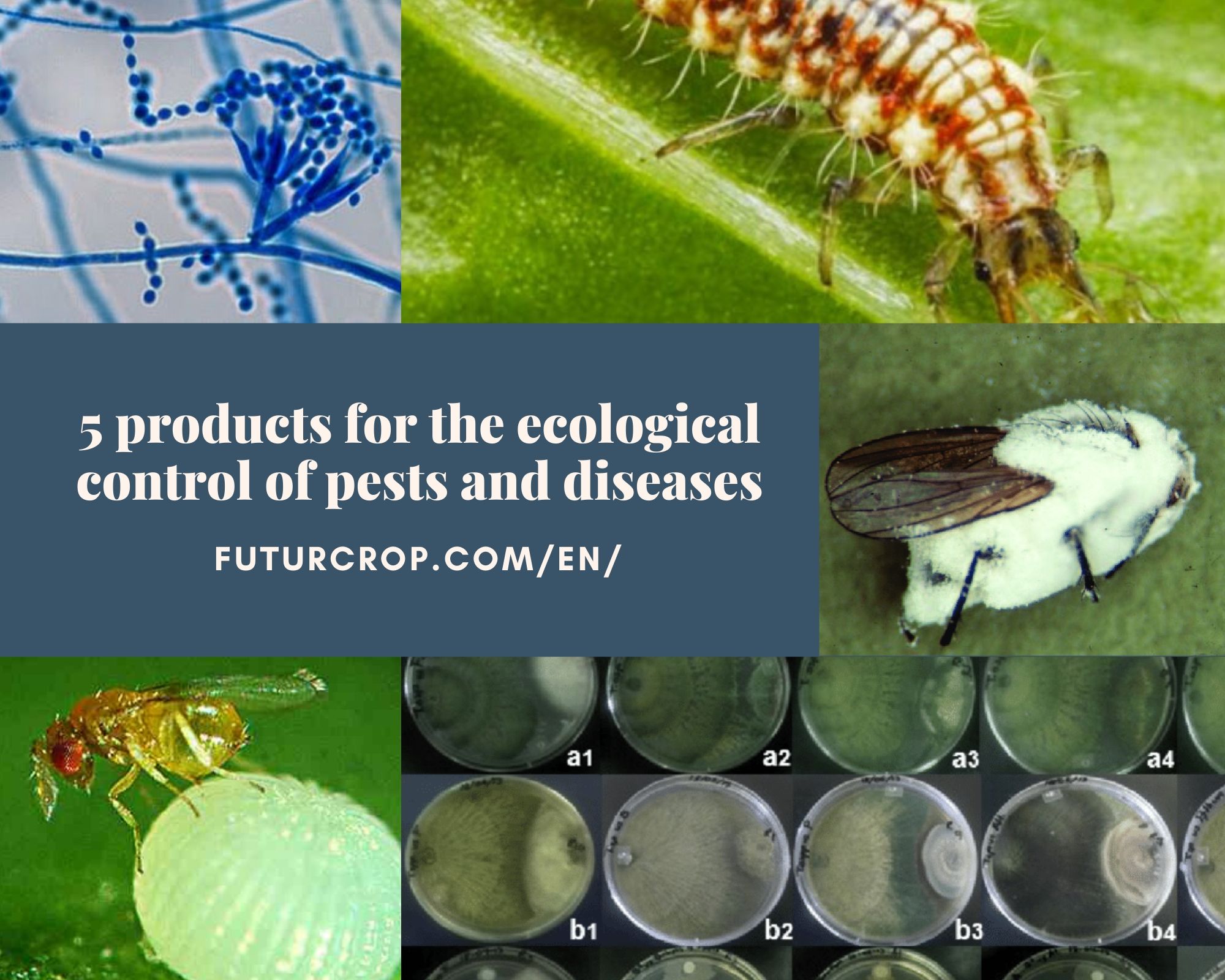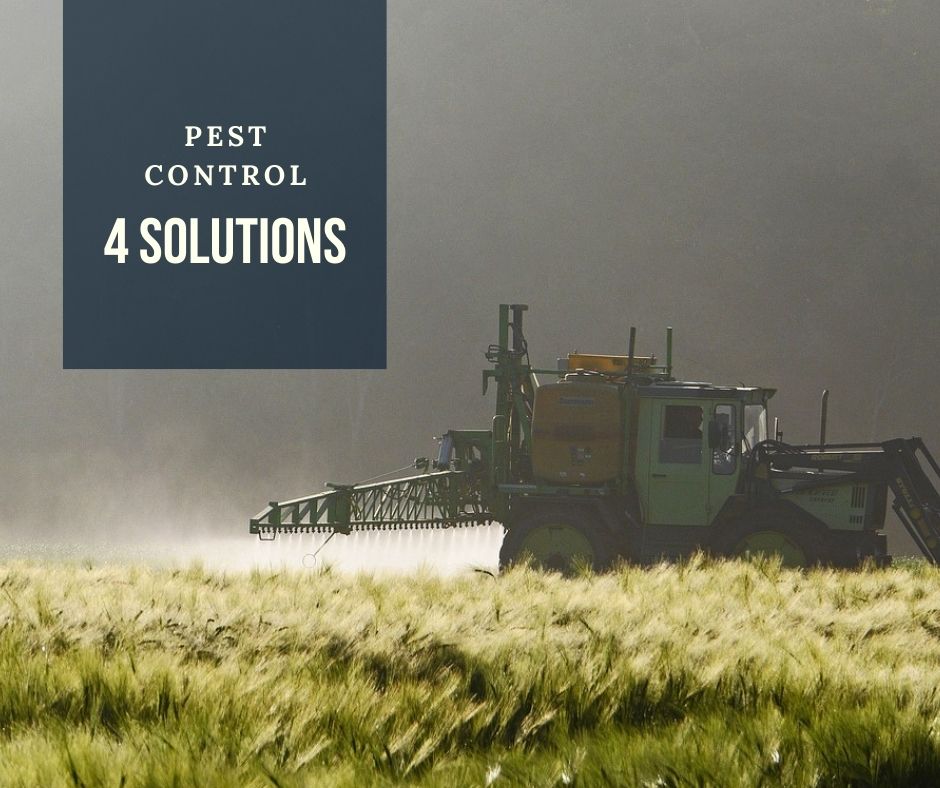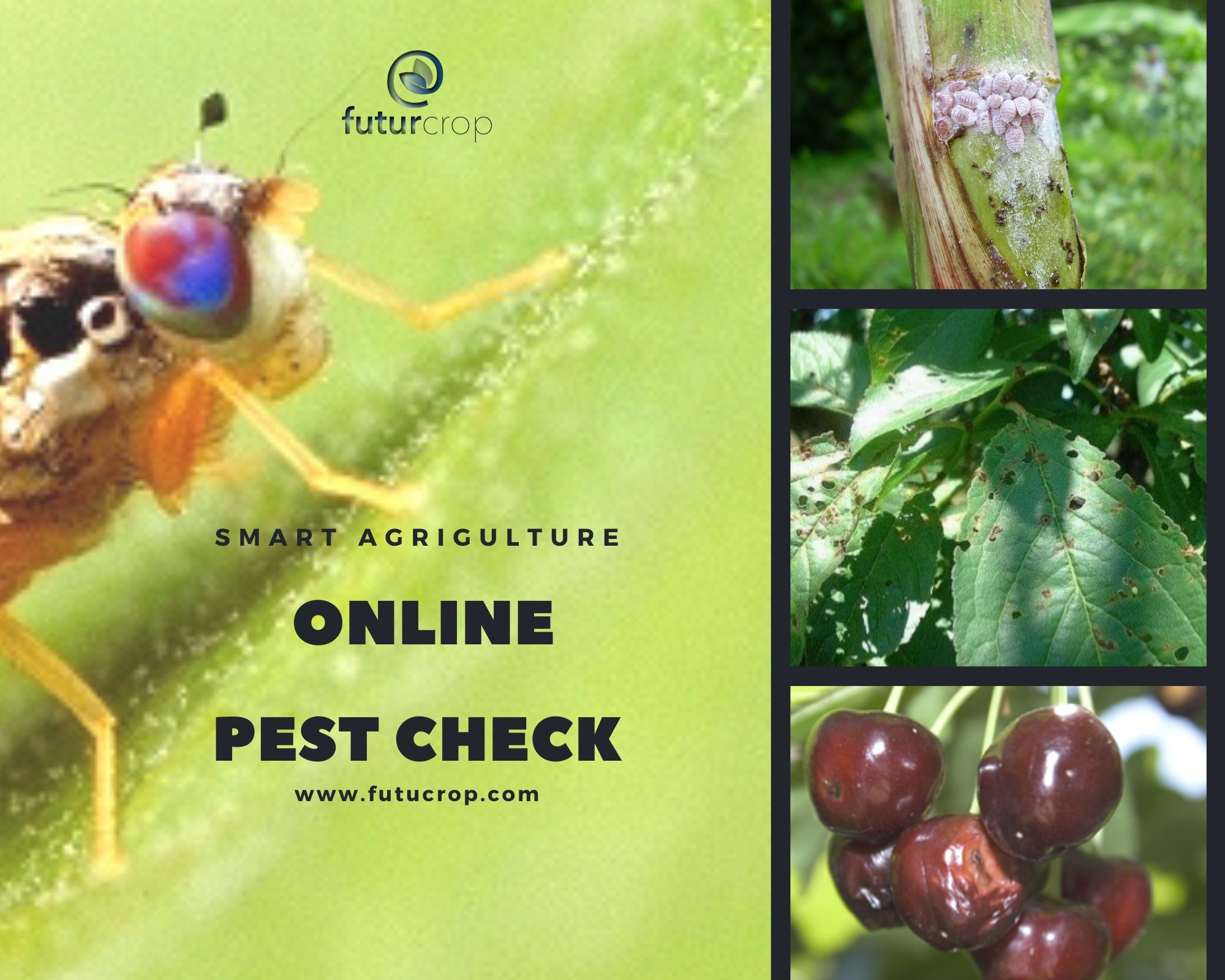5 products for the ecological control of pests and diseases

Futurcrop - 18-06-2020
Other products than chemical insecticides are nowadays available for pest controlling, basically using entomopathogenic fungi and predatory or parasitoid insects. Companies sell organisms that have always been present in the agriculture, but intensive farming methods have altered their natural action.
5 types of products stand out for the ecological control of pests and diseases, as they are the most widely used. Three of them are fungi (Trichoderma, Beauveria, Paecilomyces) and the other two are insects, predators, and pest parasitoids (Crisopera and Trichogramma).
Trichoderma
Fungi that act as competitive hyperparasites when they interact with other fungi of the genera Phytophthora, Rhizoctonia, Scierotiums, Pythium and Fusarium. Thricoderma are used in the composition of many anti fungal products because they are easily isolated and cultivated, and grow quickly on a large number of substrates. They are used to control certain phytopathogenic fungi in the soil and fungal diseases such as wilt, root and / or neck rot of the plant, Mildew, White Speck and Botrytis.
Often, to have more commercial value, Trichoderma fungus are combined with other beneficial microorganisms such as mycorrhizae, nitrogen-fixed bacteria (such as Azotobacter spp., Azospirillum spp.), phosphorus or potassium solubilizing bacteria, etc.
A great advantage of Trichoderma is its simple homemade production. Generally, leguminous crops are used, due to their ease of germination, rapid growth and ability to add nitrogen to the soil. Instructions for non-industrial manufacturing can be easily found on the internet.
Beauveria bassiana
This fungus, which grows naturally in the soil, is currently sell as biopesticide, controlling a large number of pests (200 arthropods), such as caterpillars, termites, whiteflies, aphids, beetles. It is used for controllin pest such as Hypothenemus hampei, diamondback moth (Plutella xylostella), banana borer (Cosmopolites sordidus), Phyllophaga spp., Potato beetle (Leptinotarsa decemlineata), Cydia pomonella, banana weevil (Cosmopolites sordidus), corn borer (Ostrinia furnacalis), etc. Although it can also have a detrimental effect on pollinators and other beneficial insects.
Through the fungus contact with the insect and, after its germination, introduces itself inside through its soft parts, and colonizes its cavities. The fungus then produces toxins that break the pathogen's immune system, invading all the tissues, and causing the death of the insect.
As with all biological pest control organisms, the success of Beauveria bassiana treatments depend on its application under specific environmental conditions (regarding temperature and humidity), the target pest being in the appropriate development state, and the effective contact of the fungus with the insect, otherwise it will have no action. Foliar is the most regular application, but Beauveria is also used in traps, with organisms inoculated with the fungus and adding pheromones as an attractant; and, through drench irrigation.
Paecilomyces
Paecilomyces is a genus of fungi used in contact nematicide products (nematodes are worms, damaging to the roots of various crops), and some insects such as whiteflies. It is found in the soil, decaying plants, and food. Paecilomyces lilacinus is one of the most commercialized species. It comes in granular or liquid form. It is effective for nematodes of the genera Meloydoginae, Pratelynchus and Rapophulus. The fungus parasitizes the eggs and female nematodes. The conidia produced by the fungus become attached to the external wall of the nematode body, germinate and produce specialized structures to penetrate the nematode body. Inside it, Paecilomyces feeds on the insect nutrients and reproduces en masse, until it causes its death.
Paecilomyces is applied to the soil in the form of a suspension of spores in water, by fumigation or by irrigation (tank mixing is not recommended, as each product must be applied separately). For optimal application the soil must be moist. If the pH is slightly acidic, it produces toxins that affect the nematode nervous system. For this reason, the mixing water must have a pH between 5.5 and 7.0, and a hardness of less than 130 ppm expressed in calcium carbonates.
To increase the treatment´s success, better to apply the Paecilomyces when the nematodes are in their egg phase, as they aremore fragile in that stage. Keep in mind that Paecilomyces takes between 3 and 14 days to take effect, depending on the treatment conditions.
The product can be stored for up to 4 months, refrigerated at a temperature between 1 and 10ºC.
Trichogramma
A genus of wasps that act as endoparasites of the eggs of some 28 species of agriculture pest, mainly lepidoptera, such as Helicoverpa zea, Cydia pomonella, Ostrinia nubilalis, and also aphids. Female wasps lay their eggs within the eggs of other insects, and their larvae consume the embryo and other contents of the parasitized egg.
It is used for the control of pests, such as Cydia pomonela, Diatraea spp, Heliothis sp., Plutella xylostella, Spodoptera spp., Etc.
The success predatory or parasitoids insects for pest control dependent on multiple factors, and usually it requires certain advice:
- When to release the wasp.
The farmer receive the wasp as a pupa inside the egg of the host. If upon receipt of the shipment adult emergency is observed, it is necessary to release it immediately. If it is not possible, and needs to be stored, it has to be refrigerated between 8ºC and 15ºC, and applied as soon as possible. If there is no adult emergency, better wait for this to happen before applying the treatment.
The pest biological development.
Before releasing beneficial insects, it is important to know the development stage and population level of the pest. There are some means of knowing the development stage of the pest (Expert Systems such as FuturCrop), that garanty the success of the treatment. The parasitoid must be released when there are abundant eggs. If there is not and Decision Support System it is recommended to monitor and release Trichogramma as soon as the first adults are observed. The use of pheromones is often recommended to monitor the initial flights of adults, anticipating the laying of eggs. But the success of the treatment is reduced by lack of this specific information.
The successive releases depend on the phenological stage of the crop and the stage of biological development of the pest.
The success of the treatment depends largely on the moment of release of the parasitoid. Under laboratory conditions at 23ºC, Trichogramma females parasitize an average of 60 eggs in 7 days. 90% of the laying is done in the first two days.
Weather conditions
Trichogramma individuals are active with air temperature between 15ºC and 32ºC, with an optimum temperature of 23-25ºC and relative humidity of 75%.
Trichogramma pupae can be kept for up to 1-2 days, at a temperature of 12-18ºC, being careful not to break the cold chain, and using a storing shady place. It is recommended not to keep them more than 48 hours after its receipt.
Chrysopidae
The green lacewing (Chrysoperla carnea) is a predatory insect whose larvae are marketed as a biological control mechanism for aphids, but also for whitefly, spider mite, thrips and moth egg larvae. Although its commercial use has become widespread, lacewing is an insect that appears spontaneously in all crops that can be affected by aphids, provided that chemical treatments that kill them are not carried out. They are naturally found in weeds, and are transferred to crops when pests appear. Its development can be enhanced by planting controlled plants, as indicated in the reference at the end of this post.
As adults are not predators, companies sell eggs or larvae as biological control organisms, in the form of a mixture of lacewing eggs and an inert medium, such as wheat bran or rice husk. Some companies sell adult lacewings, but they are ineffective, as they can fly to other places. Larvae are cannibals, so they must be separated during transport. This is achieved with a cell structure that keeps them separate, cell structure that can be opened row by row to let them out. Some companies sell loose larvae in cans that also contain buckwheat, that provides them with places to hide from each other.
Chrysopidae releases have the problem that should be done at specific times. Generallyl, because predatory or parasitoid insects have a very short life cycle, they must released in the crop as soon as possible, after receipt. But for the treatment to be successful, the life cycle of the pest must be taken into account (the largest the population of pest larvae and eggs, the better), as well as the meteorological conditions (although Chrysopidae tolerate from 12 to 35ºC thermal fluctuations).
They should not be stored more than 1-2 days, always at a temperature of 8-10 ° C, using horizontal containers, in shady places. Otherwise, they would lose quality and the effectiveness of treatments could be affected.
Posts relacionados
Pest control efficiency in agriculture
Real time pest and diseases prediction models
FuturCrop improves the monitoring of pests and the effectiveness of treatments
Measures to control whiteflies

Solution to 4 common agricultural pest control problems
Online pest identification tool, by type of crop damage.
